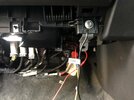kitsune
New Member
Hello everyone,
I've got a VIOFO A129 Dashcam and wanted to do a hardwire install. The camera has worked when powered by USB or from the cigarette lighter but when attempting to wire it up with the hardwire kit it does not power up at all.
To test the hardwire kit, I'm using the fuse box located in the back of the car as it is easier to access. I've found two fuses to tap into, using the volt meter I can see that they deliver around 12 volts constantly. They are both powered when the engine is running, I haven't been able to find a fuse that is powered when the engine is switched off though but I'm not planning on using the parking mode.
So I've plugged the yellow and red wires to the fuses and the black wire to a ground point. With the volt meter I can see 12 volts passing between the ground point and the black wire so there is a circuit from the fuse to the ground with the hardwire kit in between.
I've set the hardwire kit to the lowest settings which I think is around 11 volts, should be low enough not to cut off power to the dashcam.
So, I'm pretty certain that the hardwire kit is powered from my tests detailed above. When I plug the dashcam in I get no red light to show it is powered nor does the dash cam switch on. I've also tried enabling parking mode but it still does not indicate that it is powered.
Is there anything I may have missed or could do to find out why the dash cam is not being powered up?
Thanks
I've got a VIOFO A129 Dashcam and wanted to do a hardwire install. The camera has worked when powered by USB or from the cigarette lighter but when attempting to wire it up with the hardwire kit it does not power up at all.
To test the hardwire kit, I'm using the fuse box located in the back of the car as it is easier to access. I've found two fuses to tap into, using the volt meter I can see that they deliver around 12 volts constantly. They are both powered when the engine is running, I haven't been able to find a fuse that is powered when the engine is switched off though but I'm not planning on using the parking mode.
So I've plugged the yellow and red wires to the fuses and the black wire to a ground point. With the volt meter I can see 12 volts passing between the ground point and the black wire so there is a circuit from the fuse to the ground with the hardwire kit in between.
I've set the hardwire kit to the lowest settings which I think is around 11 volts, should be low enough not to cut off power to the dashcam.
So, I'm pretty certain that the hardwire kit is powered from my tests detailed above. When I plug the dashcam in I get no red light to show it is powered nor does the dash cam switch on. I've also tried enabling parking mode but it still does not indicate that it is powered.
Is there anything I may have missed or could do to find out why the dash cam is not being powered up?
Thanks



